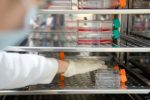A growing trend in scientific research is non-animal testing. For virtually all studies on safety or on testing and checking efficacy of ingredients, routine testing of animals has been part of the service into safety or investigation. Now there is a concerted effort to find new methods that do not rely on animals for any type of research and has a contingent fit with the vegan movement. The growth of animal cell culture and the ability to culture many types of human cells means that there is a ready availability of live material in various forms used to explore the behaviour of pharmaceuticals, cosmetics and nutritional ingredients.
Cell Cultures
Most animal cells can be grown in the laboratory although their behaviour may not be as reliable as many scientists would like to think or even predict. However, animal cells can now be grown into tissues which replicate 3D structures including miniature organs. Given that artificial meat is now a reality it’s not surprising for research labs to have developed their own specific tissues for the study of various disease states. The technology is now being adapted in conjunction with sophisticated sensing technology to recreate organs in the body.
Human Tissues
Human volunteers have donated a vast range of healthy and diseased tissue for the study of various conditions. These tissues come from biopsy, cosmetic surgery and transplants. The extraordinary range of cells available has opened up a extraordinary range of applications for study.
MatTek (Ashland, MA, USA) has developed a its patented EpiDerm system for in vitro testing of skin products. It is now a proven in vitro model system for a checking skin irritation, phototoxicity and skin corrosion. The method relies on Reconstructed Human Epidermis (RHE) which is based on normal, human-derived epidermal keratinocytes (NHEK) cultured on specially prepared tissue culture inserts.
Chip based technology (Human-On-A-Chip)
Cells and tissues can be grown on a chip which is then used to assess a variety of conditions to drugs, treatments or to explore infection by various diseases. This is one technology where it will replace existing cell-based assays and animal testing drug discovery. These systems are termed human-on-a-chip (HoC), organ-on-chip (OoC), multi-organ-on-a-chip (MoC). These are platforms that are alternative to screening of drugs. The HoC is so sophisticated it could be several human organs in a hierarchical and physiological system that resembles an in vitro human model. The intention is recreate the structural and functional integrity of a human physiology.
It relies on combining tissue engineering with microfluidics to produce a system that will mimic ADME profiling to check single and repeated dosing, disease modelling and personalised medicine.
The type of chip material used in OoC is polydimethylsiloxane (PDMS). There is an unfortunate tendency for PDMS to absorb small hydrophobic molecules. This leads to the loss of test compounds in cell-based assays and an increase in background fluorescence during observation that produces biased results in cell-based assays. Glass is now being explored as an alternative which also appears to have better cell adhesiveness (Hirama et al., 2019).
The OoC platform is used to explore cancer. The method incorporates conventional in vitro models that enable researchers to control the cellular, molecular, chemical, and biophysical parameters of the tumour microenvironment. This is in precise combination while analyzing how they contribute to tumor progression and therapy response (Dsouza et al., 2022).
Emulate (Boston, MA., USA) have developed a range of validated organ-chip systems to mimic particular tissues and organs. These include the Brain-Chip, Colon Intestine-Chip and Duodenum Intestine-Chip, Kidney-Chip, Liver-Chip and Lung-Chip.
Research with Human Volunteers
‘Microdosing’ is being explored whereby the safety of a new drug is being assessed in humans prior to large-scale human clinical safety trials. In this instance the volunteers receive a tiny once-only dose of a drug and highly sophisticated imaging technology is used to monitor the performance of the drug in the body.
Computer (in Silico) Modelling and Artificial Intelligence
Computer technology is so sophisticated that artificial intelligence is being employed to mimic human body performance. There is currently a strong role for it in medical imaging (Hasani et al., 2022).
Recognised non-animal methods: Pyrogen Testing
Pyrogen testing is one of the safety methods that is a requirement for all new ingredients that might be perceived as endotoxins or non-endotoxins. It is still a critical step for safety checking parenteral pharmaceutical products and any medical device. The standard method is to use rabbits in the rabbit pyrogen test (RPT).
An established alternative is the monocyte activation test (MAT). It was introduced into the European Pharmacopoeia in 2010 as a compendial method to replace the Rabbit Pyrogen Test (EP Chapter 2.6.30) and mentioned in FDA guidance for industry.
References
Dsouza, V. L., Kuthethur, R., Kabekkodu, S. P., & Chakrabarty, S. (2022). Organ-on-Chip platforms to study tumor evolution and chemosensitivity. Biochimica et Biophysica Acta (BBA)-Reviews on Cancer, 188717.
Hasani, N., Farhadi, F., Morris, M.A.,……….(2022) Artificial Intelligence in medical Imaging and its Impact on the Rare Disease Community: Threats, Challenges and Opportunities. PET Clinics 17(1) pp. 13-29 (Article)
Hirama, H., Satoh, T., Sugiura, S., Shin, K., Onuki-Nagasaki, R., Kanamori, T., & Inoue, T. (2019). Glass-based organ-on-a-chip device for restricting small molecular absorption. Journal of Bioscience and Bioengineering, 127(5), pp. 641-646 (Article)

Leave a Reply